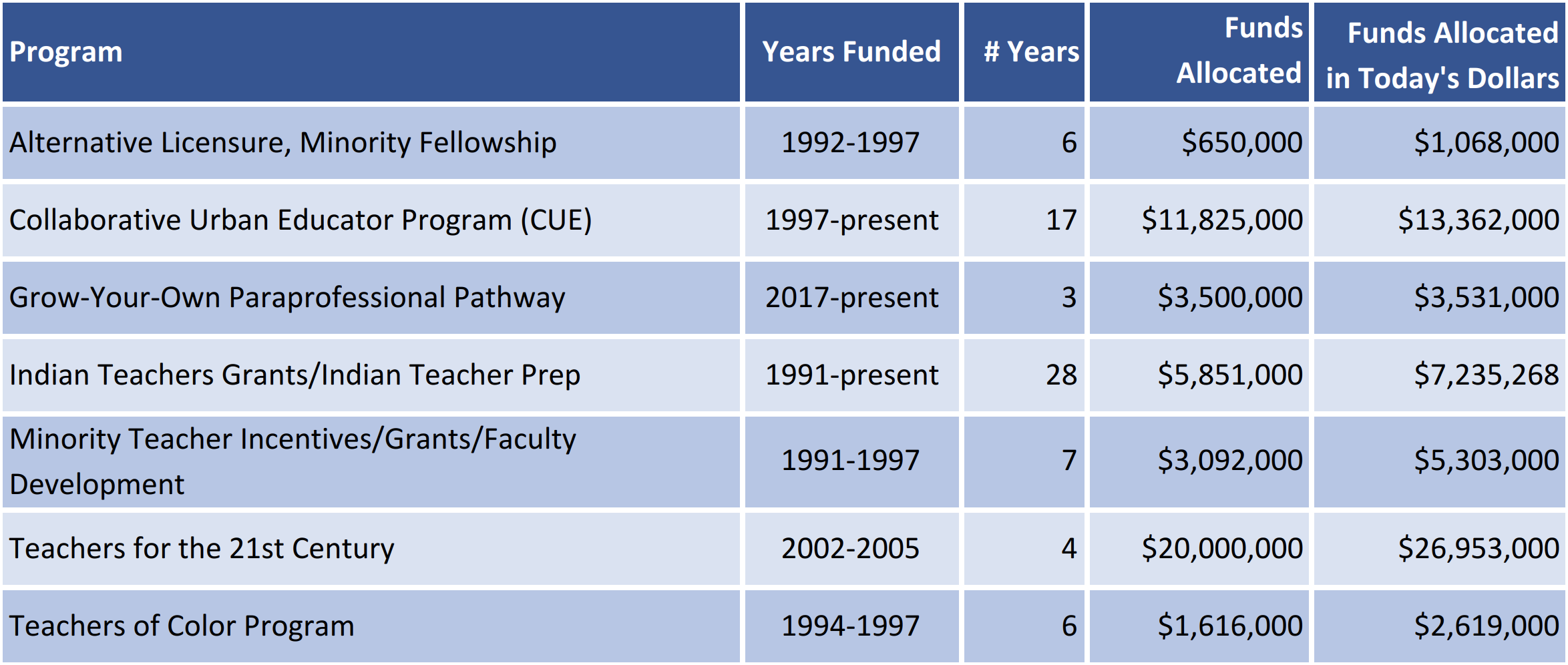This is the seventh post in a year-long blog series on teacher retention. In a prior post we examined the factors that contribute to high teacher turnover. In this entry, we look at local, state, and national data for why turnover rates are higher for teachers of color than their white peers.
Throughout this blog series we have written about why, on a general level, teachers leave the profession and the detrimental effects high turnover rates have on students and schools. However, when we dig deeper and look at the data for teachers of color, we find that the teacher retention problem is exacerbated.
Nationally, 19% of teachers of color move schools or leave the profession annually, as compared to 15% of white teachers. The mover rates—transferring from one school to another—are much higher for teachers of color. This is problematic because when a teacher moves to a different school, it can have similar impacts on the students and school as if the teacher had left the profession.
So, why do teachers of color leave the profession at higher rates than white teachers? To answer this question, we examined national, state, and local data. We also examined some Minnesota policy initiatives implemented over the past three decades to try and diversify the state’s teacher workforce.
First: Diversifying the Teaching Workforce Matters
Research has found that students of color benefit from having teachers who share their racial and ethnic identity. Specifically, when students of color have teachers of color they are more likely to graduate, be placed in gifted programs, do better academically, and are less likely to receive disciplinary referrals.

It’s not just students of color that benefit from having a teacher of color. Rather, research has found that for all students, positive exposure to individuals from a wide range of races and ethnic groups, particularly in childhood, can “help to reduce stereotypes, attenuate unconscious implicit biases and help promote cross-cultural social bonding.”
Furthermore, there is also evidence which suggests that increasing teacher diversity may benefit teachers of color who are already in the profession. There are several qualitative studies which convey the frustration, fatigue, and feelings of isolation teachers of color have when they are the only or one of a very few teachers of color in their school.
Minnesota Efforts to Diversify Teaching Workforce
Since 1991, Minnesota has spent over $60 million on policy efforts to increase teacher diversity. A few of the major programs the state has invested in are articulated in the table below. During the 2019 legislative session, over $6 million was allocated over the biennium to continue the American Indian teacher preparation grants, as well as the CUE and Grow Your Own programs.
*This table is from MNeep’s Report: The Tale of Two States: How Policy and Funding Affect Efforts to Diversify the Teaching Corps in Oregon and Minnesota
Despite these efforts, the number of teachers of color in Minnesota has increased very little. In 2006, 3.5 percent of teachers identified as teachers of color, and in 2018 this number had only grown to 4.3 percent. By comparison, in 2006, 22.8 percent of public school students in Minnesota were students of color, and in 2018 this number had grown to 34.3 percent.
The lack of movement in diversifying the teacher workforce implies that the state’s policy focus on recruitment is not enough. Rather, the efforts should also focus on retaining teachers of color who are entering the profession. However, in order to ensure the policy efforts are effective, it is imperative to have a better understanding of why teachers of color are leaving the profession at higher rates than white teachers.
Minnesota Perspective: Why Do Teachers of Color Leave?
A 2015 survey of more than 430 Minnesota educators of color in Minnesota asked what the biggest obstacles were to retaining teachers of color. The main reasons were:
- Dissatisfaction with administration;
- Dissatisfaction with test-based accountability systems;
- Lack mentoring and support;
- Racial isolation; and
- Lack of autonomy and influence.
In November 2018, Minneapolis Public Schools (MPS) released the results of their Equity and Diversity Impact Assessment (EDIA). The purpose of the EDIA was to get a better understanding of the extent to which MPS’ policies, practices, and procedures influence the recruitment, hiring, and retention of effective teachers of color. In order to do this, MPS did a series of focus groups, interviews, and surveys with teachers of color and administrators. These engagement efforts found that teachers of color endure a challenging environment at MPS, which are described in further detail below.
Persistent Negative Interactions: Teachers of color indicated that they feel they are assigned different and oftentimes additional roles based on their race and ethnicity. This includes being directed to High Priority schools, being responsible for “tough” students of color, or taking on the role of a Behavior Dean. Teachers of color also feel that they are held to a different standard than their white colleagues, and they also indicated that they often receive messages that they are not meeting those expectations. In the HR exit survey, 44% of teachers of color felt that their performance evaluation process was fair and professional, as compared to 55% of white teachers.
—MPS Teacher of Color
Isolation: Teachers of color often work in racially isolated schools—meaning there are very few, if any, teachers or administrators who share their race or ethnicity—which leads to them feeling excluded and unwelcome in their schools. According to the EDIA, “Given these persistent, negative, and exclusionary interactions, many teachers of color feel responsible for modeling respectful and inclusive interactions with their white colleagues. Ultimately, these experiences perpetuate teachers’ feelings of isolation in the workplace.” In the HR exit survey, 50% of teachers of color felt comfortable being themselves in their school, as compared to 71% of white teachers.
Job Security: Teachers of color indicated they feel targeted by their colleagues and school leaders when they confront bias and inequity in their schools. These feelings are higher amongst teachers of color who do not yet have tenure, as they are more likely to be let go during the budget process. These experiences with specific contractual obligations lead to a sense of job insecurity amongst many MPS teachers of color.
National Perspective: Why Do Teachers of Color Leave?
The findings from the 2015 Minnesota survey and MPS’ 2018 EDIA are very similar to national findings on why teachers of color leave the profession at higher rates than their white peers. According to a 2013 federal teacher survey, teachers of color indicated that the following factors were “very” or “extremely” important in their decision to leave teaching:
- Concerns about compensation tied to student performance;
- Lack of administrative support;
- Lack of classroom autonomy and school influence;
- Poor teaching conditions; and
- The desire to pursue another career or improve their opportunities in education.
In a 2016 qualitative study of black teachers across the United States, the teachers reported they face racial discrimination and stereotyping in their schools. They also indicated they did not feel respected by their white colleagues for their expertise. Rather, they reported that they were corralled into being disciplinarians; handling not only the behavioral issues of their own students but those of other teachers’ students if not the entire building. This extra responsibility disrupted their time with their students, and also detracted their planning time and professional development opportunities.
—Black teacher from 2016 EdTrust Survey
There were similar findings from a 2018 qualitative study of Latinx teachers. The teachers reported they were viewed as inferior to other teachers or only beneficial for Latinx students. They also indicated that they would receive criticism from other teachers and school leaders if they encouraged their students to speak Spanish or if they embedded culturally relevant materials into their curricula. Furthermore, many bilingual teachers reported that they often took on extra responsibilities, like translating, but were frequently overlooked for promotions.
A recent Michigan State University study confirms teachers of color feelings of bias and discrimination. The study examined teacher evaluations from 2011-2016, and found that nearly 19 percent of black teachers received a low evaluation rating from 2011-2016, compared to just 7 percent of white teachers. In particular, the study found that teachers of color, and especially black teachers, are 50 percent more likely to receive low evaluation ratings than white teachers within the same schools. The study also found that teachers of color in schools with predominantly white administrators were even more likely to receive low evaluations.
Upcoming posts in this series will feature stories and perspectives directly from educators and leaders of color about what is and is not working to increase retention.
Found this useful? Sign up to receive Education Evolving blog posts by email.
We are grateful to the McKnight Foundation for their generous financial support for this series.

